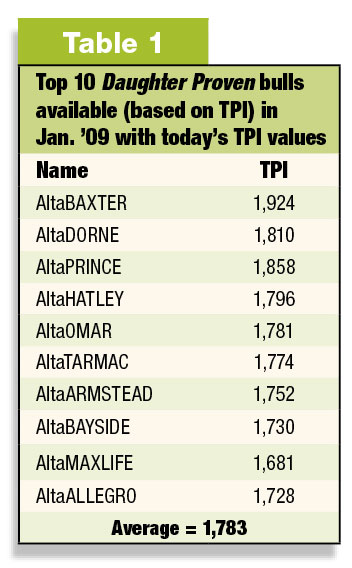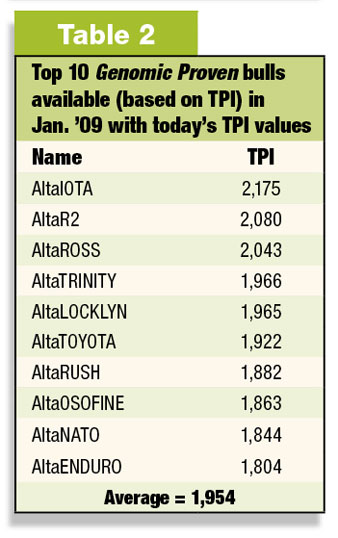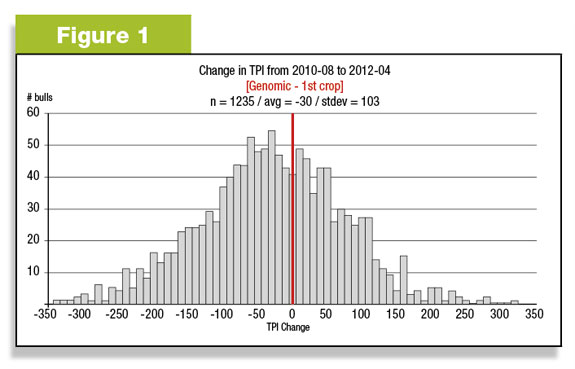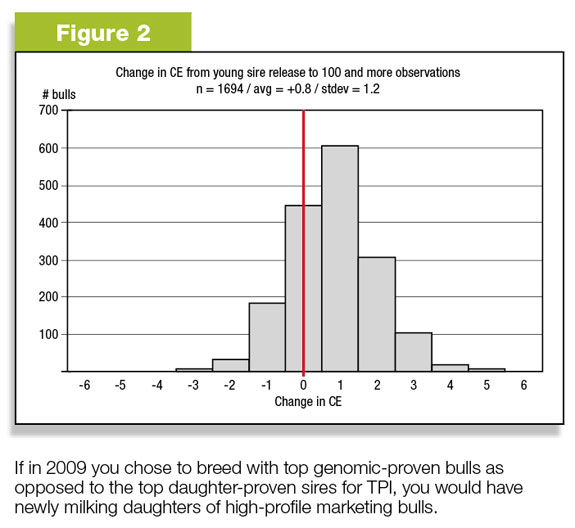No concept has been talked about more in the dairy cattle breeding world over the past few years than “genomics.” This compelling science has resurfaced a global intrigue for genetics. It is a very compelling science and has made genetics as popular of a topic as it was following the advent of artificial insemination. But why is genomics such a big deal? Because it really works.
Genomics have been official since January 2009. When it emerged in 2009, many were hesitant to adopt the technology. However, with early genomic success stories pouring in, there’s no time like the present to jump on the genetic progress train.

Selection decisions in 2009
Those who did adopt the technology in its infancy are truly reaping benefits today. If in 2009 you chose to breed with top genomic-proven bulls as opposed to the top daughter-proven sires for TPI, you would have newly milking daughters of high-profile marketing bulls.
On the other hand, most chose to “wait and see,” and therefore used the top daughter-proven bulls (Table 1). This is a great group of bulls in its own right, and they have made happy customers around the globe, but the top genomic sires at that time (Table 2 below right) are clearly a superior group genetically.
Proof stability
What about the risk of these genomic chart-toppers dropping? Be not afraid – 1,235 bulls were genomic tested in August 2010 and have producing daughters now in April 2012. The average drop in TPI is only 30 points.

Yes, some dropped more, some less, some stayed the same and some increased. What matters here though is the group average, as this is how genomic bulls should be used – in groups.
Figures 1 & 2, below, further illustrate expected changes from a genomic to a first-crop proof. The proof change value from August 2010 to April 2012 is indicated on the horizontal axis and the number of bulls with a certain change is indicated on the vertical axis.
It shows that of 1,235 total bulls, about 40 had exactly zero change in their TPI. Meanwhile, the largest positive change was +325 TPI points and the largest drop was -350 TPI points. You can therefore infer that the chance of a genomic bull decreasing or increasing by 350 TPI points is 0.1 percent (1/1235).

Likewise we can see about 95 percent of bulls are within +/- 200 TPI points from their initial genomic prediction, after they receive their daughter proofs.
Similar graphs for other genetic traits show that proof changes are normally distributed and, for most traits, the average change is very near zero. The exception is PL, where the average change is -0.6, meaning genomic predictions are slightly overestimating this trait.
That, however, does not mean the predictions are invalid or the trait should not be considered on a genomic sire – only that you can expect a small drop on any genomic-proven sire. For PL, 95 percent of bulls change between -2.1 and +1.0, so the range is still relatively tight, and high-ranking bulls based on genomics can be expected to continue to be high-ranking bulls after they get milking daughters.
The proof stability graphs also show a large number of bulls change in the positive direction for all traits, so even though we don’t know which bulls will go up or down with daughter proofs, we can’t forget the upside. Remember, the reliability of genomic proofs is around 75 percent for production and type, and a bit lower for health traits.

Change in CE proofs from genomic to first crop
A common reason for hesitance to use genomic sires is due to calving ease uncertainty. Figure 2 shows a CE proof can change between genomic and first-crop proofs; however, the majority of change is up by less than 1 point (0.8% SCE).
To put exact numbers to the graph, 95 percent of bulls increased by 2+ or less.. For this reason, we recommend breeding heifers to genomic sires that are 6 or below SCE, until a bull has his own observations for CE.
Some may believe they must use “daughter-proven” sires on heifers, but we must remember bulls become “daughter-proven” for CE as soon as their first calves are born, or about one year after semen is first released.
Today’s selection decisions
Since 2009, many improvements have shaped genomic proofs estimates and numerous animals have been added to the reference population. Both factors contribute to genomic accuracy, while decreasing expected changes from genomic to first-crop proofs.
Today, like in 2009, selection options are much the same. You could use the best daughter-proven sires or genomic sires.
To maximize genetic gain and reach your breeding goal at a faster pace, genomic-proven sires are certainly the way to achieve your goals. Much like a stock portfolio, you will need to accept a bit of risk to maximize your expected return.
Of course risk can be mitigated in stocks by increasing the number of different companies owned; and with genomics, risk can be reduced by increasing the number of different sires used.
So for those eager to maximize genetic gain and accept some risk to do so, set your genetic plan carefully. Then select a group of at least five to six sires to capitalize on the opportunities your genetic plan will deliver. PD
Zwald is the senior director of global strategy & marketing for Alta Genetics.






